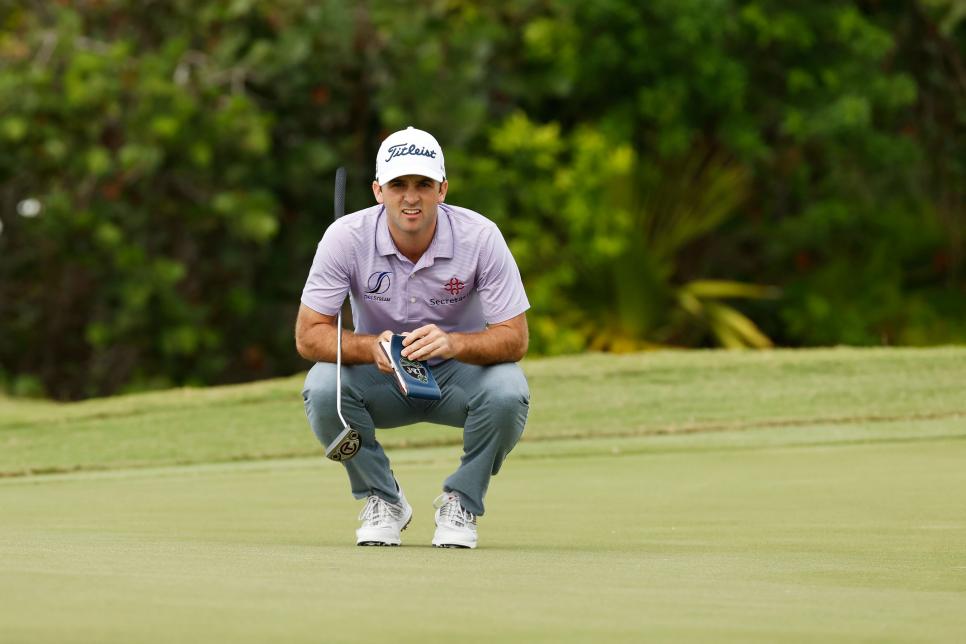News
The golf stats that matter most on the PGA Tour

Consider, for a moment, Denny McCarthy. In the 2019-20 season, he was the strokes gained/putting champion of the PGA Tour, and almost became just the second person (after Jason Day) to average an entire stroke gained over the field per round. It was his second straight mythical putting title, and it’s not even a little hyperbolic to call him one of the greatest putters on Earth. That said, if you know anything about Denny McCarthy, you know he’s not one of the greatest players on Earth. In the two seasons when he led the PGA Tour in putting, he finished 111th and 73rd in the FedEx Cup standings and only managed six top-10s in 51 tournaments. There’s no doubt that he’s very good, but there’s also no doubt that in this case, his brilliant putting didn’t translate to superlative results.
Golf, like many sports, is fertile ground for folk wisdom. If you’ve spent time around a course, you’ve heard the expression “drive for show, putt for dough.” McCarthy’s case would cast some doubt on this formulation, but of course the 27-year-old is just one person and it would be a mistake to draw any statistical conclusions from the smallest possible sample size. Right or wrong, though, the “putt for dough” idea is attempting to answer a question of critical importance for players: Which skill matters the most? Which specific aspect of golf has the greatest correlation to sustained success? And which elements are less important than we think?
To search for the answer, I reached out to Rick Gehman, founder of RickRunGood.com and a Golf Digest contributor. There are a few brilliant numbers guys in golf, and he’s one of them. As expected, he took the concept and blew it out of the water. In his words:
I’ve attached a sheet that looks at the 130 official PGA Tour stats and compares them for the 2020 season FedEx Cup Regular Season Points. With only one year, and a shortened one at that, there’s going to be more randomness than usual BUT I think the list certainly passes the eye test.
Gehman’s method was what he called a “straightforward regression model,” in which two variables are compared to each other using 129 qualifying players. The steady variable is FedEx Cup points accrued by a player during the regular season, which was our metric for success (you could argue that total strokes-gained average is better, but I wanted to go by the PGA Tour’s own standard, albeit before the points blow up in the playoffs and skew the results). The second variable is the other 130 stats, with a ranking value assigned to each based on a player’s finish in the year-end standings. By finding out which ones have the closest correlation to each other, you can see which statistics might predict success.
In simpler words, this shows us what the best players did the best.
Let me echo Gehman’s caution up top: With only an abbreviated season’s worth of data, there is bound to be some statistical noise, and to draw definite conclusions of any kind, you’d need to look at a years-long study.
With that said, the list can be found here. The higher the number, the more closely correlated the result is with FedEx Cup success. A few observations:
• As a quality control test, it’s good to see that “official money” and “Official World Golf Ranking” are the top two. Clearly, if these didn’t correlate with our concept of success, something would be seriously wrong.
• Of the comprehensive strokes-gained numbers, SG/approach the green is the most “important” to overall success. It’s the top stat after money and World Ranking, and it’s even above SG/total, which comes in fourth. That last fact is the least intuitive of the results and probably deserves closer inspection.
• The top six are: SG/approach the green, SG/off-the-tee, scoring average, SG/total, SG/around the green, and SG/tee-to-green. Again, this all stands to reason and functions as good quality control.

The saying "putt for dough" on the PGA Tour hasn't held up the last two seasons, as Denny McCarthy led both times in strokes gained/putting but finishing 111th and 76th on the FedEx Cup points list, respectively.
Gregory Shamus
• But you might have noticed something missing … where’s putting? Incredibly, SG/putting ranks 64th on the list, exactly at the halfway mark. It’s hard not to think of that number in relation to McCarthy, and while the warning above still has to be observed, it definitely raises some questions about the relative value of putting.
• Looking at the top of the list, there are a lot of stats like “birdie average” and “scoring average” that you’d expect. But when you start getting into highly specific stats, like driving distance and “approaches from > 200 yards” you see the putting categories appear only after several tee-to-green stats.
• In particular, long approaches seem to be of some importance. Approaches from longer than 175 yards seem more correlated with success than anything on the green. Greens in regulation is hugely critical, coming in 16th.
• Scrambling matters, too. Not only is SG/around the green fifth overall, but scrambling itself (31st), sand-save percentage (35th), scrambling from the rough (44th) and scrambling from 10-20 yards (49th) are all relatively high.
• Interestingly, “consecutive cuts” finished dead last, one of only two stats with a negative correlation value. Clearly, in a system like the FedEx Cup where points are top heavy, consistency without at least sporadic excellence is a dubious merit.
• In the “Bryson was right” department, driving distance average (28th) is more closely correlated with success than driving-accuracy percentage (52nd).
• If you’re looking for a magic secret stat that perfectly predicts success, you’ll be disappointed. Personally, I was hoping that we’d somehow find out that all the best players were wizards from the left rough between 150-175 yards. Alas …
After reading Gehman’s list, I wanted to try one more approach that looked only at the top 30 players on tour from last season. It’s less scientific, but I thought it might be worthwhile. Luis Rivera at the PGA Tour helped immensely by providing me with a spreadsheet of the overall ranking in all the major strokes-gained categories from the top 30 in the 2020 FEC rankings. With these numbers, it was possible to do a quick and dirty check for success correlation.

A clutch putt from Mackenzie Hughes, something his stats show he's prone to do, at the BMW Championship earned him the last spot into the 2020 Tour Championship.
Stacy Revere
With fewer players, there will be outliers, and the data will necessarily be less precise. As an example, we can look at Mackenzie Hughes, who missed nine of his first 11 cuts, then made it all the way to the Tour Championship by virtue of catching fire late. He’s in the McCarthy vein, having finished eighth in putting but worse than 140th in the other major categories. Meanwhile, Hideki Matsuyama goes the other way, cleaning up from off the green but finishing a sad 170th in putting.
Here were the average season-ending rankings for each category among this group of 30:
SG/total: 29.7
SG:/tee-to-green: 41.47
SG/approach: 52.97
SG/off-the-tee: 53.67
SG/putting: 65.73
SG/around the green: 71.9
The similarity here is that putting is relatively low, and the biggest difference comes with “around the green,” which looks a lot less significant here. (Also, fans of strokes gained will be relieved to know that SG/total is No. 1 here, as you’d expect it to be.) Again, Gehman’s method is the more sophisticated metric, and should take precedence, but it’s interesting to see what changes and what doesn’t with a slightly different method.
The broad conclusion is that when you look at 2020, tee-to-green golf seems to be a more useful skill than putting. In the real world, a great player needs both, but we may want to get ahead of the curve and tweak that famous expression: Putt for show, do everything else for dough.